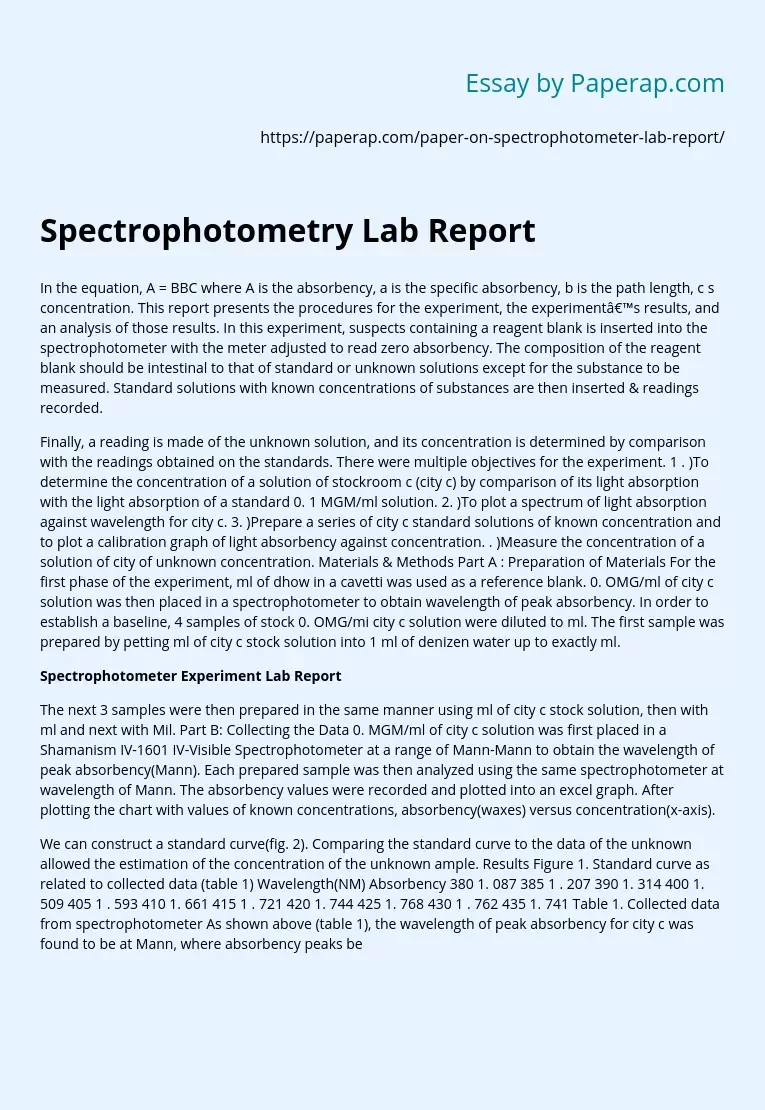Spectrophotometry Lab Report
In the equation, A = BBC where A is the absorbency, a is the specific absorbency, b is the path length, c s concentration. This report presents the procedures for the experiment, the experiment’s results, and an analysis of those results. In this experiment, suspects containing a reagent blank is inserted into the spectrophotometer with the meter adjusted to read zero absorbency. The composition of the reagent blank should be intestinal to that of standard or unknown solutions except for the substance to be measured.
Standard solutions with known concentrations of substances are then inserted & readings recorded.
Finally, a reading is made of the unknown solution, and its concentration is determined by comparison with the readings obtained on the standards. There were multiple objectives for the experiment. 1 . )To determine the concentration of a solution of stockroom c (city c) by comparison of its light absorption with the light absorption of a standard 0. 1 MGM/ml solution. 2. )To plot a spectrum of light absorption against wavelength for city c.
3. )Prepare a series of city c standard solutions of known concentration and to plot a calibration graph of light absorbency against concentration. . )Measure the concentration of a solution of city of unknown concentration. Materials & Methods Part A : Preparation of Materials For the first phase of the experiment, ml of dhow in a cavetti was used as a reference blank. 0. OMG/ml of city c solution was then placed in a spectrophotometer to obtain wavelength of peak absorbency. In order to establish a baseline, 4 samples of stock 0.
OMG/mi city c solution were diluted to ml. The first sample was prepared by petting ml of city c stock solution into 1 ml of denizen water up to exactly ml.
Spectrophotometer Experiment Lab Report
The next 3 samples were then prepared in the same manner using ml of city c stock solution, then with ml and next with Mil. Part B: Collecting the Data 0. MGM/ml of city c solution was first placed in a Shamanism IV-1601 IV-Visible Spectrophotometer at a range of Mann-Mann to obtain the wavelength of peak absorbency(Mann). Each prepared sample was then analyzed using the same spectrophotometer at wavelength of Mann. The absorbency values were recorded and plotted into an excel graph. After plotting the chart with values of known concentrations, absorbency(waxes) versus concentration(x-axis).
We can construct a standard curve(fig. 2). Comparing the standard curve to the data of the unknown allowed the estimation of the concentration of the unknown ample. Results Figure 1. Standard curve as related to collected data (table 1) Wavelength(NM) Absorbency 380 1. 087 385 1 . 207 390 1. 314 400 1. 509 405 1 . 593 410 1. 661 415 1 . 721 420 1. 744 425 1. 768 430 1 . 762 435 1. 741 Table 1. Collected data from spectrophotometer As shown above (table 1), the wavelength of peak absorbency for city c was found to be at Mann, where absorbency peaks before dipping down at Mann & Mann respectively.
Figure 2. Standard curve as related to collected data (table 2) Final concentration of city c (MGM/ml) Absorbency at lambda Max 0. 08 1. 420 0. 6 1 . 076 0. 04 0. 708 0. 02 0. 355 Table 2. Tabulated data of the 4 samples after dilutions As shown in table 2 above, the final concentrations of city c were obtained from the dilution formula, CIVIC = C.V. where CLC is the initial concentration, VI is the initial volume, CA is the final concentration, VI is the final volume. Thus a final concentration of 0. MGM/ml of city c for sample 1 can be calculated via, 0. MGM/ml x ml = ? X ml 0. 4/5 = 0. MGM/ml The subsequent figures of the other samples were then plugged into the graph which resulted in a straight line, or standard curve. The graph accurately depicts that as the concentration of city c is increased, its absorbency also increases. Unknown 0. 825 Table 3. Unknown concentration of unknown sample with 0. 825 absorbency at lambda Max Figure 3. City c concentration of unknown estimated to be 0. MGM/ml From figure 3 above, it illustrates that the concentration of the unknown falls between the range of 0. 4-0. MGM/ml. Thus it can be concluded that the estimated concentration of unknown sample could be around 0. MGM/ml. Discussion In the initial phase of the lab, it demonstrated the use of a spectrophotometer o analyze the optimal wavelength of absorbency for different solutes. The instrument operates by passing a beam of light through a sample and measuring the intensity of light reaching a detector. The beam of light consists of a stream of photons. When a photon encounters an analyze molecule, there is a chance the analyze will absorb the photon.
This absorption reduces the number of photons in the beam, thereby reducing the intensity of the light beam reaching the detector (N. Blanch. ,2014). Thus stockroom c, based on this concept of spectrophotometer, peak absorbency was found to be at Mann (table. ). Thus this particular wavelength was chosen to measure the concentration of the unknown city c sample. For the second phase of the lab, it illustrated the direct association between the concentration of particles in a solution and the amount of light that could pass through.
This is in accordance to Beer’s Law which states that the absorbency of a species at a particular wavelength of electromagnetic radiation, is proportional to the concentration of the absorbing species(F. Schneider. ,2013) From figure 2 above, the graph shows a straight line, which illustrates the direct proportionality f concentration vs.. Absorbency, whereby increasing concentration of analyze also increases its absorbency. Thus the sample obeys the Beer-Lambert Law. For the third phase of the lab, applying the principles of Beer’s Law and the concept of spectrophotometer.
Spectrophotometry Lab Report. (2019, Dec 05). Retrieved from https://paperap.com/paper-on-spectrophotometer-lab-report/

